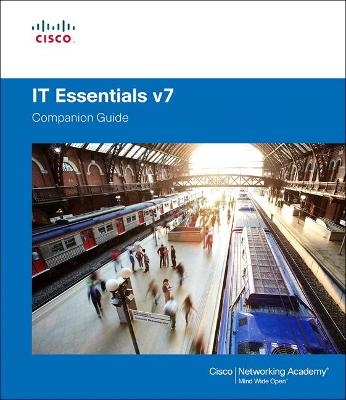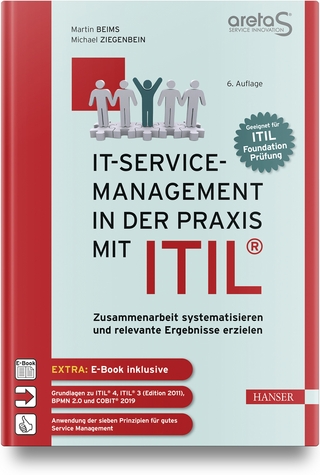
IT Essentials Companion Guide v7
Cisco Press (Verlag)
978-0-13-564537-6 (ISBN)
The features of the Companion Guide are designed to help you study and succeed in this course:
· Chapter objectives–Review core concepts by answering the focus questions listed at the beginning of each chapter.
· Key terms–Refer to the updated lists of networking vocabulary introduced, and turn to the highlighted terms in context.
· Course section numbering–Follow along with the course heading numbers to easily jump online to complete labs, activities, and quizzes referred to within the text.
· Check Your Understanding Questions and Answer Key–Evaluate your readiness with the updated end-of-chapter questions that match the style of questions you see on the online course quizzes.
This book is part of the Cisco Networking Academy Series from Cisco Press®. Books in this series support and complement the Cisco Networking Academy.
Cisco Networking Academy is an innovative Cisco education initiative that delivers information and communication technology skills to improve career and economic opportunities around the world. The Academy provides online courses, interactive tools, and lab activities to prepare individuals for information technology and networking careers in virtually every industry.
Introduction xxxiii
Chapter 1 Introduction to Personal Computer Hardware 1
Objectives 1
Key Terms 1
Introduction to Personal Computers (1.0) 4
Personal Computers (1.1) 4
What Is in a Computer? (1.1.1) 4
Electrical and ESD Safety (1.1.2) 5
PC Components (1.2) 6
Case and Power Supplies (1.2.1) 6
Motherboards (1.2.2) 12
CPUs and Cooling Systems (1.2.3) 16
Memory (1.2.4) 18
Adapter Cards and Expansion Slots (1.2.5) 25
Hard Disk Drives and SSDs (1.2.6) 28
Optical Storage Devices (1.2.7) 32
Ports, Cables, and Adapters (1.2.8) 34
Input Devices (1.2.9) 42
Output Devices (1.2.10) 50
Computer Disassembly (1.3) 53
The Technician’s Toolkit (1.3.1) 53
Computer Disassembly (1.3.2) 53
Summary (1.4) 54
Practice 54
Check Your Understanding Questions 55
Chapter 2 PC Assembly 59
Objectives 59
Key Terms 59
Introduction to PC Assembly (2.0) 61
Assemble the Computer (2.1) 61
General and Fire Safety (2.1.1) 61
Open the Case and Connect the Power Supply (2.1.2) 62
Install the Motherboard Components (2.1.3) 65
Install Internal Drives (2.1.4) 69
Install the Adapter Cards (2.1.5) 74
Select Additional Storage (2.1.6) 81
Install the Cables (2.1.7) 84
Summary (2.2) 90
Practice 91
Check Your Understanding Questions 91
Chapter 3 Advanced Computer Hardware 95
Objectives 95
Key Terms 95
Introduction to Advanced Computer Hardware (3.0) 98
Boot the Computer (3.1) 98
POST, BIOS, CMOS, and UEFI (3.1.1) 99
BIOS/UEFI Configuration (3.1.2) 104
Electrical Power (3.2) 107
Wattage and Voltage (3.2.1) 107
Power Fluctuation and Protection (3.2.2) 109
Advanced Computer Functionality (3.3) 111
CPU Architectures and Operation (3.3.1) 111
RAID (3.3.2) 117
Ports, Connectors, and Cables (3.3.3) 119
Monitors (3.3.4) 135
Computer Configuration (3.4) 140
Upgrade Computer Hardware (3.4.1) 140
Configurations for Specialized Computers (3.4.2) 145
Protecting the Environment (3.5) 155
Safe Disposal of Equipment and Supplies (3.5.1) 155
Summary (3.6) 158
Practice 159
Check Your Understanding Questions 159
Chapter 4 Preventive Maintenance and Troubleshooting 163
Objectives 163
Key Terms 163
Introduction (4.0) 164
Preventive Maintenance (4.1) 164
PC Preventive Maintenance Overview (4.1.1) 164
Troubleshooting Process (4.2) 167
Troubleshooting Process Steps (4.2.1) 167
Common Problems and Solutions for PCs (4.2.2) 176
Apply Troubleshooting Process to Computer Components and Peripherals (4.2.3) 185
Summary (4.3) 188
Practice 188
Check Your Understanding Questions 189
Chapter 5 Networking Concepts 193
Objectives 193
Key Terms 193
Introduction (5.0) 196
Network Components and Types (5.1) 196
Types of Networks (5.1.1) 196
Internet Connection Types (5.1.2) 203
Networking Protocols, Standards, and Services (5.2) 207
Transport Layer Protocols (5.2.1) 208
Application Port Numbers (5.2.2) 213
Wireless Protocols (5.2.3) 217
Network Services (5.2.4) 222
Network Devices (5.3) 232
Basic Network Devices (5.3.1) 232
Security Devices (5.3.2) 238
Other Network Devices (5.3.3) 242
Network Cables (5.4) 246
Network Tools (5.4.1) 246
Copper Cables and Connectors (5.4.2) 251
Fiber Cables and Connectors (5.4.3) 256
Summary (5.5) 262
Practice 263
Check Your Understanding Questions 263
Chapter 6 Applied Networking 267
Objectives 267
Key Terms 267
Introduction (6.0) 269
Device to Network Connection (6.1) 269
Network Addressing (6.1.1) 269
Configure a NIC (6.1.2) 280
Configure a Wired and Wireless Network (6.1.3) 286
Firewall Settings (6.1.4) 299
IoT Device Configuration (6.1.5) 307
Basic Troubleshooting Process for Networks (6.2) 309
Applying the Troubleshooting Process to Networks (6.2.1) 310
Network Problems and Solutions (6.2.2) 313
Summary (6.3) 319
Practice 319
Check Your Understanding Questions 320
Chapter 7 Laptops and Other Mobile Devices 325
Objectives 325
Key Terms 325
Introduction (7.0) 328
Characteristics of Laptops and Other Mobile Devices (7.1) 328
Mobile Device Overview (7.1.1) 329
Laptop Components (7.1.2) 336
Laptop Display Components (7.1.3) 341
Laptop Configuration (7.2) 344
Power Settings Configuration (7.2.1) 344
Wireless Configuration (7.2.2) 346
Laptop Hardware and Component Installation and Configuration (7.3) 350
Expansion Slots (7.3.1) 351
Replacing Laptop Components (7.3.2) 356
Other Mobile Device Hardware Overview (7.4) 360
Other Mobile Device Hardware (7.4.1) 360
Specialty Mobile Devices (7.4.2) 364
Network Connectivity and Email (7.5) 368
Wireless and Cellular Data Networks (7.5.1) 368
Bluetooth (7.5.2) 374
Configuring Email (7.5.3) 378
Mobile Device Synchronization (7.5.4) 383
Preventive Maintenance for Laptops and Other Mobile Devices (7.6) 388
Scheduled Maintenance for Laptops and Other Mobile Devices (7.6.1) 388
Basic Troubleshooting Process for Laptops and Other Mobile Devices (7.7) 391
Applying the Troubleshooting Process to Laptops and Other Mobile Devices (7.7.1) 391
Common Problems and Solutions for Laptops and Other Mobile Devices (7.7.2) 395
Summary (7.8) 401
Practice 402
Check Your Understanding Questions 402
Chapter 8 Printers 407
Objectives 407
Key Terms 407
Introduction (8.0) 409
Common Printer Features (8.1) 409
Characteristics and Capabilities (8.1.1) 409
Printer Connections (8.1.2) 413
Printer Type Comparison (8.2) 417
Inkjet Printers (8.2.1) 417
Laser Printers (8.2.2) 423
Laser Printing Process (8.2.3) 427
Thermal Printers and Impact Printers (8.2.4) 434
Virtual Printers (8.2.5) 437
3D Printers (8.2.6) 438
Installing and Configuring Printers (8.3) 442
Installing and Updating a Printer (8.3.1) 442
Configuring Options and Default Settings (8.3.2) 444
Optimizing Printer Performance (8.3.3) 446
Sharing Printers (8.4) 448
Operating System Settings for Sharing Printers (8.4.1) 448
Print Servers (8.4.2) 451
Maintaining and Troubleshooting Printers (8.5) 454
Printer Preventive Maintenance (8.5.1) 454
Inkjet Printer Preventive Maintenance (8.5.2) 456
Laser Printer Preventive Maintenance (8.5.3) 456
Thermal Printer Preventive Maintenance (8.5.4) 457
Impact Printer Preventive Maintenance (8.5.5) 459
3D Printer Preventive Maintenance (8.5.6) 460
Applying the Troubleshooting Process to Printers (8.5.7) 461
Problems and Solutions (8.5.8) 464
Summary (8.6) 468
Practice 469
Check Your Understanding Questions 469
Chapter 9 Virtualization and Cloud Computing 473
Objectives 473
Key Terms 473
Introduction (9.0) 474
Virtualization (9.1) 474
Virtualization (9.1.1) 474
Client-Side Virtualization (9.1.2) 478
Cloud Computing (9.2) 483
Cloud Computing Applications (9.2.1) 483
Cloud Services (9.2.2) 484
Summary (9.3) 488
Practice 488
Check Your Understanding Questions 489
Chapter 10 Windows Installation 493
Objectives 493
Key Terms 493
Introduction (10.0) 495
Modern Operating Systems (10.1) 495
Operating System Features (10.1.1) 495
Customer Requirements for an Operating System (10.1.2) 500
Operating System Upgrades (10.1.3) 504
Disk Management (10.2) 509
Disk Management (10.2.1) 509
Installation and Boot Sequence (10.3) 515
Basic Windows Installation (10.3.1) 515
Custom Installation Options (10.3.2) 517
Windows Boot Sequence (10.3.3) 524
Summary (10.4) 528
Practice 528
Labs 528
Check Your Understanding Questions 529
Chapter 11 Windows Configuration 533
Objectives 533
Key Terms 534
Introduction (11.0) 538
Windows Desktop and File Explorer (11.1) 538
Comparing Windows Versions (11.1.1) 539
The Windows Desktop (11.1.2) 542
Windows Task Manager (11.1.3) 554
Windows File Explorer (11.1.4) 556
Configure Windows with Control Panels (11.2) 567
Control Panel Utilities (11.2.1) 567
User and Account Control Panel Items (11.2.2) 575
Network and Internet Control Panels (11.2.3) 579
Display Settings and Control Panel (11.2.4) 588
Power and System Control Panels (11.2.5) 591
Hardware and Sound Control Panels (11.2.6) 600
Clock, Region, and Language (11.2.7) 604
Programs and Features Control Panels (11.2.8) 608
Other Control Panels (11.2.9) 610
System Administration (11.3) 614
Administrative Tools (11.3.1) 614
System Utilities (11.3.2) 624
Disk Management (11.3.3) 631
Application Installation and Configuration (11.3.4) 639
Command-Line Tools (11.4) 644
Using Windows CLI (11.4.1) 644
File System CLI Commands (11.4.2) 650
Disk CLI Commands (11.4.3) 666
Task and System CLI Commands (11.4.4) 670
Other Useful CLI Commands (11.4.5) 675
Windows Networking (11.5) 680
Network Sharing and Mapping Drives (11.5.1) 680
Sharing Local Resources with Others (11.5.2) 685
Configure a Wired Network Connection (11.5.3) 688
Configure a Wireless Network Interface in Windows (11.5.4) 695
Remote Access Protocols (11.5.5) 697
Remote Desktop and Assistance (11.5.6) 699
Common Preventive Maintenance Techniques for Operating Systems (11.6) 700
OS Preventive Maintenance Plan (11.6.1) 700
Backup and Restore (11.6.2) 704
Basic Troubleshooting Process for Windows Operating Systems (11.7) 707
Applying Troubleshooting Process to Windows Operating Systems (11.7.1) 707
Common Problems and Solutions for Windows Operating Systems (11.7.2) 711
Advanced Troubleshooting for Windows Operating Systems (11.7.3) 716
Summary (11.8) 720
Practice 721
Check Your Understanding Questions 722
Chapter 12 Mobile, Linux, and macOS Operating Systems 727
Objectives 727
Key Terms 727
Introduction (12.0) 729
Mobile Operating Systems (12.1) 729
Android vs. iOS (12.1.1) 729
Android Touch Interface (12.1.2) 734
iOS Touch Interface (12.1.3) 737
Common Mobile Device Features (12.1.4) 741
Methods for Securing Mobile Devices (12.2) 755
Screen Locks and Biometric Authentication (12.2.1) 755
Cloud-Enabled Services for Mobile Devices (12.2.2) 758
Software Security (12.2.3) 763
Linux and macOS Operating Systems (12.3) 767
Linux and macOS Tools and Features (12.3.1) 767
Linux and macOS Best Practices (12.3.2) 778
Basic CLI Commands (12.3.3) 783
Basic Troubleshooting Process for Mobile, Linux, and macOS Operating Systems (12.4) 793
Applying the Troubleshooting Process to Mobile, Linux, and macOS Operating Systems (12.4.1) 794
Common Problems and Solutions for Other Operating Systems (12.4.2) 798
Summary (12.5) 805
Practice 805
Check Your Understanding Questions 806
Chapter 13 Security 811
Objectives 811
Key Terms 811
Introduction (13.0) 814
13.1 Security Threats (13.1) 814
Malware (13.1.1) 814
Preventing Malware (13.1.2) 820
Network Attacks (13.1.3) 825
Social Engineering Attacks (13.1.4) 830
Security Procedures (13.2) 834
Security Policy (13.2.1) 834
Protecting Physical Equipment (13.2.2) 835
Protecting Data (13.2.3) 841
Data Destruction (13.2.4) 847
Securing Windows Workstations (13.3) 849
Securing a Workstation (13.3.1) 849
Windows Local Security Policy (13.3.2) 855
Managing Users and Groups (13.3.3) 860
Windows Firewall (13.3.4) 869
Web Security (13.3.5) 876
Security Maintenance (13.3.6) 882
Wireless Security (13.4) 885
Configure Wireless Security (13.4.1) 886
Basic Troubleshooting Process for Security (13.5) 900
Applying the Troubleshooting Process to Security (13.5.1) 900
Common Problems and Solutions for Security (13.5.2) 904
Summary (13.6) 906
Practice 907
Check Your Understanding Questions 908
Chapter 14 The IT Professional 913
Objectives 913
Key Terms 913
Introduction (14.0) 915
Communication Skills and the IT Professional (14.1) 915
Communication Skills, Troubleshooting, and Professional Behavior (14.1.1) 915
Working with a Customer (14.1.2) 917
Professional Behavior (14.1.3) 919
The Customer Call (14.1.4) 922
Operational Procedures (14.2) 925
Documentation (14.2.1) 925
Change Management (14.2.2) 928
Disaster Prevention and Recovery (14.2.3) 931
Ethical and Legal Considerations (14.3) 934
Ethical and Legal Considerations in the IT Profession (14.3.1) 935
Legal Procedures Overview (14.3.2) 940
Call Center Technicians (14.4) 944
Call Centers, Level One and Level Two Technicians (14.4.1) 944
Basic Scripting and the IT Professional (14.4.2) 949
Summary (14.5) 958
Practice 959
Check Your Understanding Questions 959
Appendix A Answers to “Check Your Understanding” Questions 965
Glossary 985
9780135645376 TOC 1/30-2020
| Erscheinungsdatum | 30.12.2019 |
|---|---|
| Reihe/Serie | Companion Guide |
| Verlagsort | Indianapolis |
| Sprache | englisch |
| Maße | 208 x 238 mm |
| Gewicht | 1742 g |
| Themenwelt | Mathematik / Informatik ► Informatik ► Theorie / Studium |
| Informatik ► Weitere Themen ► Zertifizierung | |
| ISBN-10 | 0-13-564537-9 / 0135645379 |
| ISBN-13 | 978-0-13-564537-6 / 9780135645376 |
| Zustand | Neuware |
| Haben Sie eine Frage zum Produkt? |
aus dem Bereich



